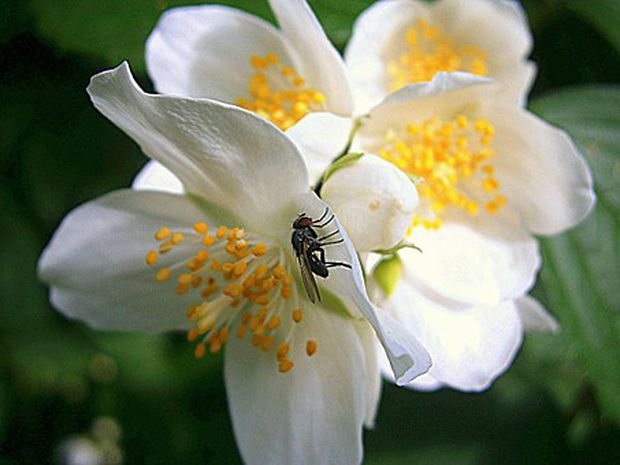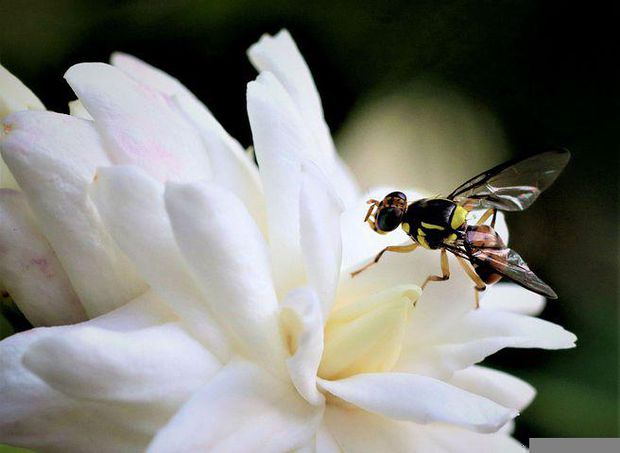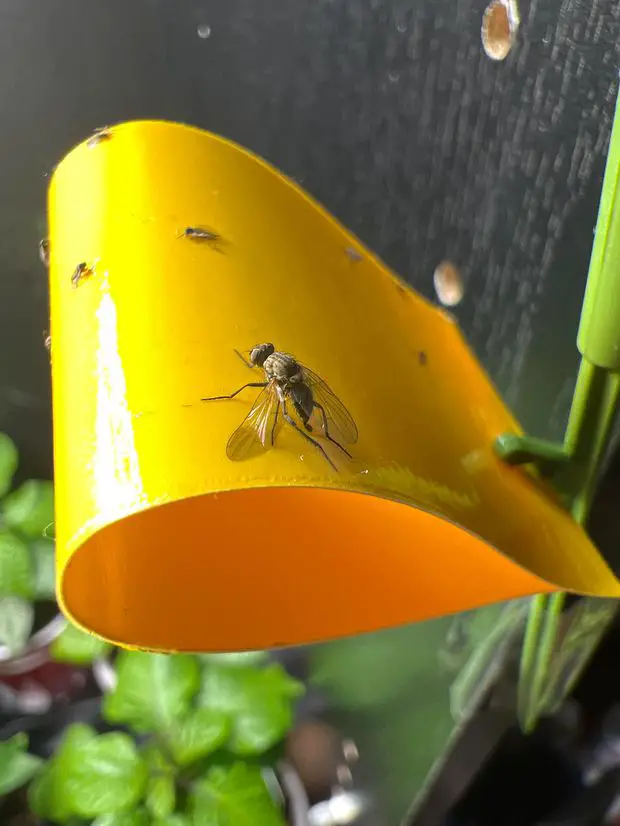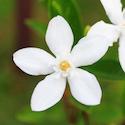As we have learnt from other posts, jasmine indoor plants, vines and shrubs are prone to get damaged by different bugs. However, most of jasmine species will be strong enough to withstand most of flying insects infestations.

Especially, when the warmer season starts and throughout the summer until pretty much the winter time, bees, wasps, hummingbirds, flies and other flying insects begin to populate our precious jasmine plants.
One very recurrent issue that most common jasmine specie suffer from, is related to its flowers being eaten by flies. Many people see the flowers decaying and you may wonder if, do jasmine plants attract flies?
Usually, many flying insects are commonly named as “flies’, like small moths, whiteflies, small bees and so on, but the true flies belong to the Order of Diptera, meaning that they bear only one set of functional wings. We can include houseflies, hover flies, blowflies and short flies.
Generally speaking, dipterans feature sucking mouthparts and some do feed on the sap of plants and others feed on decomposing organic matter and blood. The dipterans that feed on the plant juices, they do so whilst pollinating those flowers at the same time. Although, still not the kind of bugs you would necessarily want in your plants!
If you observe your jasmine plants being either infested or resting bugs all around you the flowers and leaves, you would most likely have houseflies or gnat flies. No matter the kind of flies you might be having around your jasmine plant, here we are going to go through which types of flies exist and methods to get rid of them!
Depending on the flies specie, they will affect your jasmine plants in different ways and there can be several reasons why they may be all over your flowers. Not all the flies will be deterrent to your jasmine plants but they will need to be under watch.
Yes, jasmine plants do attract flies. They attract the common housefly, hoverflies, fungus gnats, shore flies and fruit flies. Your jasmine plant will attract those flies depending on the specie food interest. Some will feed on flower nectar or honeydew, such as, the housefly or hoverfly. Whereas some, will feed on the organic debris, like fallen leaves and lay their eggs in the moist soil, such as, fungus gnats and shore flies. There are several ways to remove those flies around your jasmine plant, like, sticky traps, insecticides, physical and biological methods, and the placement of decoy plants among others.
TYPES OF FLIES THAT JASMINE PLANT ATTRACT
Housefly
Houseflies are the common, medium sized and black flies that really ruin our warm season sessions! They eat about anything. More frequently available sources of foods include, rotting fruits, vegetables and other decomposing organic waste.
But they don’t limit their feeding to just those, but also, decaying bodies of animals, manure, flower nectar and sugary products, such as, honeydew! Essentially, anything they can find pungent and wet enough will be a good source of attraction and our jasmine plant is a good example.
Research has shown, that jasmine plants do attract flies (houseflies) due to the nectar of their flowers but mostly due to the honeydew expelled by aphids or whiteflies infecting such jasmine plant.
As we know, honeydew is a rich in carbohydrates substance and it is a food source for most dipteran species, as well as ants and wasps. The ways houseflies are attracted to jasmines, are by orienting themselves around the odour from honeydew accumulated in jasmine crops (and other crops for that matter) and they feed on it.
Not only that, but also, these odour will attract them for them to feed whilst depositing their eggs in jasmine leaves or nearby plants.
Research also shows that houseflies are attracted to jasmine plants by the odours from the sooty mold growing on honeydew.
Hoverflies
Hoverflies, are a beautiful type of flies that love your jasmine flowers! That’s why they are also known as flower flies.
At a first glance, they might look like bees or wasps, rather than flies, as they also have their abdomen stripped like them, but having a closer look at them, you will realise that they are in fact flies. They will feed on your jasmine flowers, from the nectar and pollen, just like hummingbirds.
Having said that, they are not all bad for two different reasons. Firstly, they fulfil an important ecological function, which is the process of pollination. They usually, mostly, target flowers that are about to decay soon, ensuring that they are pollinated whilst feeding on them.
Secondly, hoverflies larvae feed on aphids, scales, and caterpillars, and we all know how prone to aphids our beloved jasmine plants are. Therefore, the might clean your plant form an aphid infestation at the price of a couple of flowers!

Fungus Gnats
Gnats are black flies that look like mosquitoes and the way they can be harmful to your jasmine plants is by laying their eggs buried in the soil and the larvae will feed on organic matter (and sometimes on the fungus that your jasmine plant might have) in the soil bedding, and thus, harming the roots of the jasmine plant.
This is particularly visible during the hottest months when the soil remains wet for longer periods of time and most importantly in indoors jasmine plants that have been taken outdoors in the summer time.
To help removing those nasty bugs, make sure to replace the potting soil as soon as you see those bugs around. It is very important to allow some time for the soil to dry up a bit before you water the jasmine again. Also, ensure you get rid of the organic debris in the first layer of the soil and get rid of the foliage that has fallen off. Make use of gravel mulch in a way that the gnats are not able to deposit more eggs in your jasmine plants soil.
There are also, commercially available fungus gnats traps that will have a sticky layer that will release some pheromones that will attract those gnats and they will get sticked to the trap.
Lastly, if your jasmine plant is really covered with these bugs, you could try a biological control approach. Especially if you have it indoors, it is likely that they will also infest plants near by.
The way it works is by using a nematode specie called Steinernema feltiae, that will prey on the eggs and larvae of these gnats and other mites.
These nematodes are usually commercially available only but make sure to follow the instructions in the pack.
Shore Flies
Shore flies are small and black flies that might look very similar to fungus gnats, but they display light colours in their wings. Similarly to gnats, they feed on the roots and will thrive and infest the wet soil of your jasmine plants and the fallen leaves.
Same as with gnats, the methods to get rid of them would be similar. Make sure to prune off the parts of the plant that are in decline and make sure not to overwater the soil of your jasmine plant. Clean up the fallen debris as they also like the decomposing organic matter. There are some pesticides that will help in the case of a bad infestation but make sure to follow the instructions of the label as you can kill your plant.
Whiteflies
Whiteflies are a very common pest in jasmine pants. They are very attracted to jasmine plant sap. Whiteflies are tiny white flies and sometimes they might have very subtle stripes in their wings. They have very soft bodies and they relate to aphids and mealybugs. Whiteflies feed on the sap of jasmine plant, especially from the underside of the leaves. Unfortunately, they not only weaken the plant by leaving those leaves yellow and stunt, but also, when feeding, very much like aphids and houseflies, they leave behind a sugary and sticky substance called honeydew.
When this happens, not only, ants will appear to feed on this carbohydrate rich solution, but also, some fungus will grow, called sooty mold, further damaging your jasmine plant.
Please note that they especially tend to appear during the warmer moths of the year, hence you will need to be alert, so that, you can act quickly and save your plant.
The best ways to eliminate these annoying bugs, are to first of all, quickly prune the leaves infested with them (at least they are quite easy to spot!) then, hose off the jasmine plant, give it a good wash to dislodge the bugs and the larvae from the leaves. Keep your plant away from other plants so that they don’t get contaminated.
Another good way, which have also mentioned above, is sticky traps. These, might resemble the foliage of your jasmine plants and are commercially available. Although, I am all for DIY recipes, and you can mimic these traps by using a card coated with a layer of petroleum jelly on it or simple sticky tape and place them on your jasmine plant. This is a good way to get rid of adult whiteflies in the plant but the eggs and larvae will remain in the leaves.

A method that is efficient but should be done very carefully, is by using a vacuum cleaner in the lower setting. This will suck all the adult bugs and eggs and will reduce the whiteflies population meaningfully. It is important to dispose of the filter immediately after not to contaminate nearby plants or your houseplants.
In conclusion, it is important to remember to act quickly as a soon as you identify that your plant has been infested with flies or they are roaming around too much around your jasmine. The most efficient methods to remove them are among others, to water your jasmine less often. Don’t overwater them and allow sometime for the soil to dry up, it should be moist, not soggy, otherwise, it will be the perfect field for reproduction for certain types of flies.
For your indoors jasmine, you can place some decoy plants for the females to lay the eggs in there rather than in your jasmine. Those pots should then be destroyed every two weeks to avoid the maggots to reproduce and find the way to your jasmine pots.
Don’t forget to use a gravel or pebbles mulch in your jasmine plants to stop the flies from laying their eggs in the soil.
The use of sticky traps can be very beneficial and efficient in trapping flies, thus breaking their life cycles.
Also, removing the rotting and decaying organic debris at the base of your plant is crucial to stop the life span and cycle of the flies. Shake off the soil and start over with fresh new potting soil.
Lastly, the use of pesticides rich in pyrethrins, israelensis or resmethrin, as well as biological approaches with nematodes are also a fantastic ways to help your jasmine plants with those annoying flies.

